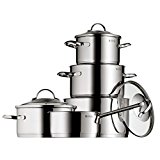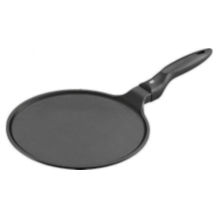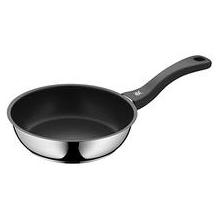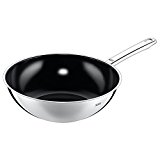Dutch oven purchasing advice: how to choose the right product
- What you need to know
- Dutch ovens can be used both indoors and outdoors for roasting, baking, frying, and braising.
- You can put hot coals on the lid to make it act like an oven.
- You need to season your Dutch oven before using it for the first time.
- Only use water when cleaning your Dutch oven, otherwise you can damage the seasoning.
A timeless all-in-one
Dutch ovens are ever more popular, and for good reason. While more and more people are using them in their kitchens, they are also a fantastic option for outdoor cooking. They are extremely durable, heat-resistant, and thermally conductive. Traditionally, Dutch ovens have three legs which means they are very stable on uneven surfaces such as campfires. Highly durable, Dutch ovens are just as good during long adventures through the wilderness as they are in your garden. This versatility has meant they are still very popular in the modern age.
Dutch oven, Chuck Wagon Oven, Camp Oven or Potje – these cast-iron pots have had many names. At the start of the eighteenth century, the Dutchman Abraham Darby brought his cast-iron production process over to England and called his cooking pot a Dutch oven. In time, this style of pot became extremely popular in British colonies around the world, especially in America. This is because Dutch ovens are fantastic for cooking outside. They became so popular in the United States, that many people nowadays romantically associate them with the Frontier.
Dutch babies in Dutch ovens?
Due to their similar names, you might be wondering if you can cook Dutch baby pancakes in a Dutch oven. The answer is yes. Dutch babies are basically just oven pancakes, so Dutch ovens are a great option for making them.
Seasoning a Dutch oven
Before using your Dutch oven, it is essential to season it properly. This is where you create a layer of fat or oil, also known as a patina, that gives the pot its non-stick properties and prevents food from burning. You can buy pre-seasoned Dutch ovens, but the process is relatively simple if you want to do it yourself. Read on for a quick run-down.
Clean
Most Dutch ovens come with an anti-rust coating. You’ll need to remove this before seasoning your pot, so wash any Dutch oven with water and dish soap beforing seasoning it.
Oil
Oil the inside of your Dutch oven with a little cooking oil. It is important to use an oil with a high smoke point to prevent burning. Sunflower and peanut oil are good options, but you can use any oil that can withstand a fair amount of heat. If you have too much oil in the bottom of your pan, wipe it up with some kitchen paper.
Bake
If you’re using a fire, put your Dutch oven in it with the opening facing downwards. You can put the lid on the three legs if your model has them. If you are using an oven, put the Dutch oven in with the opening facing upwards – you’ll have to season the lid separately.
Remove the heat
After an hour at 400 °F (200 °C) you can take your Dutch oven away from the heat. The interior of the pan should have a deep matt black layer. This means the oil has successfully turned into a layer of seasoning.
Cool down
Let your Dutch oven cool down. Now you’re ready to start using it!
Usage tips
While Dutch ovens are highly durable cooking utensils, there are a few tips to ensure it has the longest life possible. Read on for a few of these, as well as some other useful information so you can really get the most out of yours.
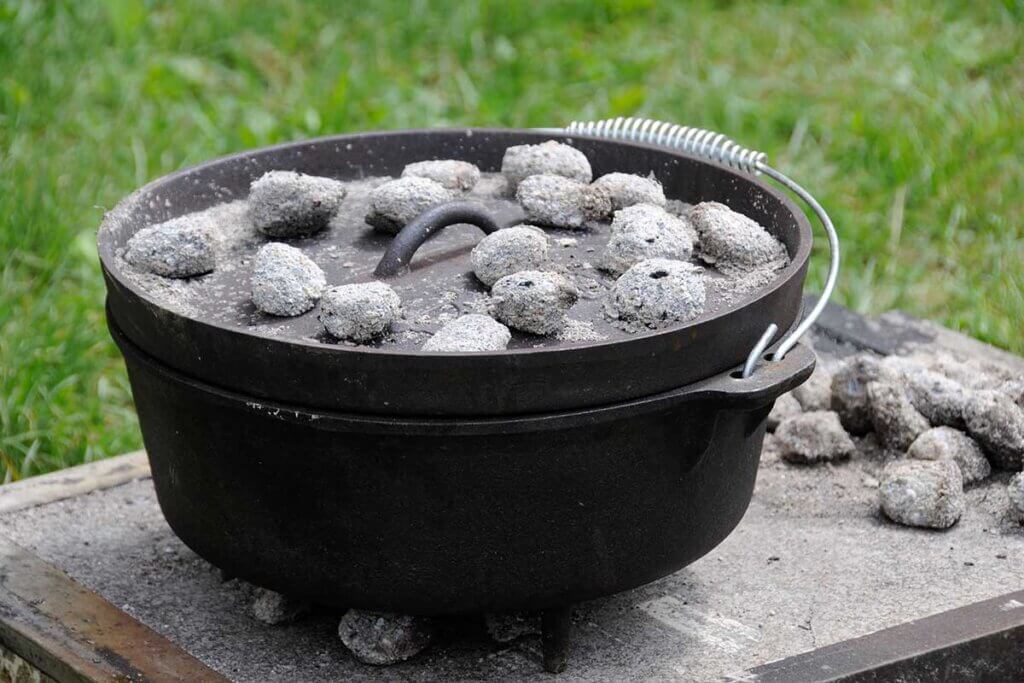
Even heating
Dutch ovens can be used as mini ovens. Thanks to the flat lid with a raised rim, you can place hot coals or wood directly onto the lid. This means that the Dutch oven will be heated from above and below, cooking whatever is inside evenly.
Patience
Patience truly is a virtue when using a Dutch oven. When cooking large quantities in yours, resist the urge to open the lid and check on the food. This will allow steam to escape, which both slows down cooking, and can mean that your meal turns out dry.
Lid versatility
You can use the lid of your Dutch oven as more than just a lid. In fact, you can even use it as a frying pan. Just put it straight onto the glowing embers. Be careful when taking it off though, as it can get extremely hot.
Indoor and outdoor cooking
Dutch ovens with three legs are specially designed for outdoor cooking. The legs mean it can sit stably among the coals in a fire. If you want to cook in your kitchen with a Dutch oven, make sure you get a model without feet. You can use such a Dutch oven either on your cooktop or in your oven.
Cooking temperature
Ideal cooking temperature depends on what you are preparing. Most manufacturers will give you an indication of how many coals you need to put on top of your Dutch oven to reach a certain temperature. Make sure to stick to these recommendations, or you could end up with burnt food!
Hot and cold
While cast iron pots are extremely strong and durable, they don’t deal well with sharp temperature changes. Never put cold water directly into your Dutch oven when it is hot. This can cause the metal to deform.
Protect the patina
The first few times you cook with your Dutch oven, avoid preparing acidic dishes such as tomato sauce. These can damage the patina layer of oil seasoning. The more you cook with your Dutch oven, the stronger the patina gets, so you will eventually be able to cook acidic things.
Warning: hot!
Dutch ovens can get extremely hot while cooking. As a result, they also can take a while to cool down. When handling your hot Dutch oven, make sure to use oven-safe gloves or, better yet, tongs.
Buying tips
Dutch ovens are simple objects, but there are still a few things you should look out for when choosing one.
Style and shape
Traditional Dutch ovens have three feet. This is because they are specifically designed to be placed directly into a fire, on top of hot coals. Likewise, the lids on these Dutch ovens often have feet too, so you can use them as a frying pan. This style of Dutch oven is only good if you’re just planning on cooking over coals with it. You won’t be able to use it on your cooker as the contact between burner and pot is too little.
Dutch ovens without legs can be used on a wide range of cookers – even induction ones. This said, they are also suitable for outside cooking. You might want to get a stand or a hanger, in case the pot isn’t stable enough on top of the coals.
Most Dutch ovens are round. Some manufacturers also sell rectangular designs. These usually don’t have feet, and are specially designed to fit in convection ovens. Other than this, the shape of a Dutch oven doesn’t really make any difference.
Size
The larger the Dutch oven, the longer it will take to heat up. If you’re just cooking for yourself or a couple of others, you won’t need a huge one, so check the size of any pot you’re buying. Most manufacturers will specify the size of their Dutch ovens in quarts. As a rule, you’ll need one quart of space per person you are cooking for.
A further thing to consider is that cast iron can be quite heavy. Dutch ovens can weigh a lot, especially when filled with food. Make sure you don’t get something too heavy.
Material
Dutch ovens are made from cast iron, and only cast iron. Don’t bother with any other materials. When picking one, try to make sure that the metal has an even thickness all over. This will ensure that it heats up evenly. It’s also worth checking how thick the feet and handles are – if they are too thin, they could break at high temperatures.
Accessories
Most Dutch ovens don’t come with any accessories. At most, they might have a travel bag and a lid hook (for lifting the lid off when hot). Dutch ovens with inbuilt thermometers are extremely rare. You can get models without feet that come with stands.

There are a few other accessories that can make using your Dutch oven safer and easier. These include oven gloves and pokers. You can use the gloves to pick the pot up when it is hot, and the poker to move the embers around on your campfire to create the perfect cooking zone.
Price
Size, build quality, and manufacturer all influence the price of a Dutch oven. As a rule, good models tend to cost between $40 and $180. At the bottom of this price range, you can still get Dutch ovens with all the necessary features. While you can even get a Dutch oven for $20, the build quality is usually pretty poor, so we wouldn’t recommend them.
Cleaning, maintenance, and storage
Cast iron is a highly durable material, and you can get many years of use out of a Dutch oven. However, for this to happen, you need to look after it properly.
Care
One of the most important aspects to any cast iron pot is the patina or seasoning. Ideally, you should re-oil your Dutch oven after each time you use it, to strengthen the protective layer. If you notice that the layer is damaged in any way, you need to re-season your Dutch oven before you use it again.
Cleaning
When it comes to cleaning your Dutch oven, the main thing to know is that you shouldn’t use any kind of detergent or dish soap. This can both damage the pot and impart chemical flavors into the pot’s patina layer. To clean your Dutch oven, use hot water and let any tough bits of grime soak. When the water is cold, you should be able to clean your Dutch oven easily with a wooden spoon and a sponge.
Storage
Never store your Dutch oven wet, or in a damp place. The moisture can cause the iron to rust. Likewise, you shouldn’t store it with the lid on top – it is important for air to circulate to prevent the oil patina layer from going rancid. A good solution is to put a folded kitchen towel between the lid and the pot.
Image 1: © aufgetischt / stock.adobe.com | Image 2: © FinalCheck

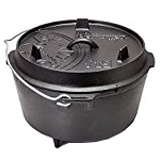

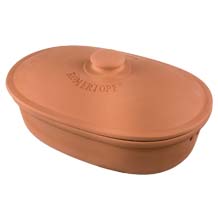
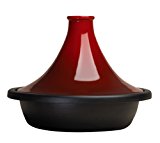
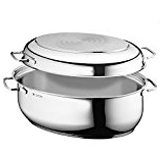
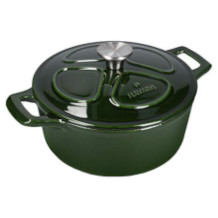

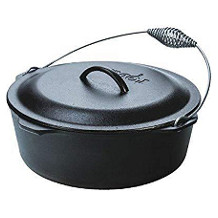
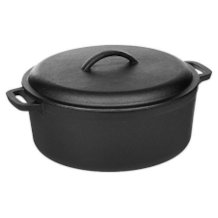
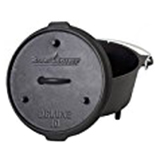
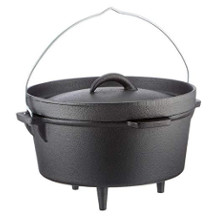
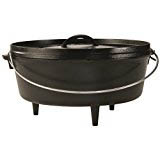
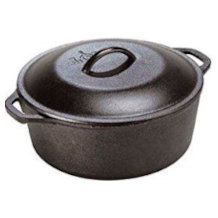
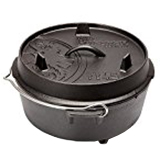
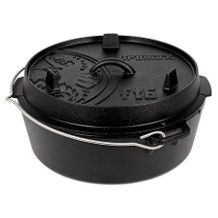
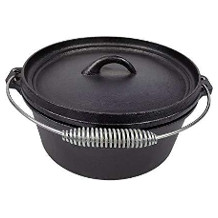
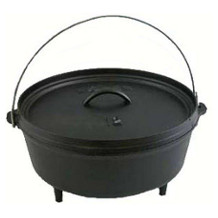
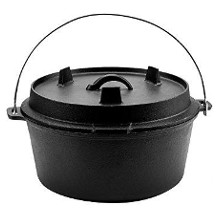
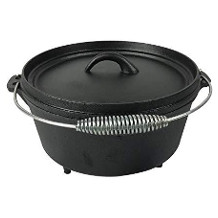

 2,116 reviews
2,116 reviews

